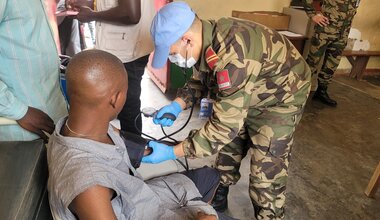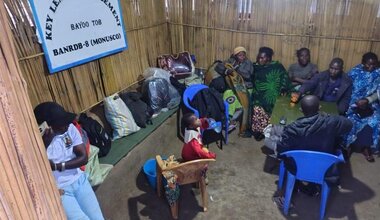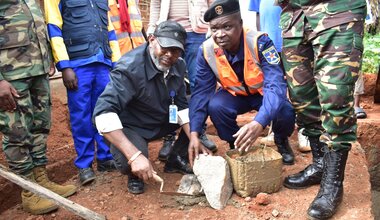Ituri: MONUSCO Provides Temporary Work for 1,500 At-Risk Youth, Including Ex-Combatants
As part of its Community Violence Reduction (CVR) projects, MONUSCO has handed over to local authorities two agricultural feeder roads and three bridges located in the villqge groupings of Zadu and Baviba, 60 kilometers from Bunia, the capital of Ituri Province. To build these infrastructures, MONUSCO called on a local workforce of some 1,500 at-risk youth, including ex-combatants and community members.
The first road, located in the villqge prouping of Zadu, is nine kilometers long and links the locality of Kagaba to that of Ngasu Odje. The work included building a new road, placing culverts and building a 45-ton capacity bridge over the Ofi River. This bridge is in addition to the 30-ton capacity Tiniya bridge built on the same stretch of road and inaugurated a few months earlier, again by MONUSCO.
The second road is located in the villqge grouping of Baviba. It is an 11-kilometer stretch of road linking the villages of Olongba and Songokoy. In addition, two bridges have been built, one over the Ati River and the other over the Adjiri stream, as well as six culverts. This road runs through about eight villages where the inhabitants used to experience the worst difficulties in evacuating their farm produce and obtaining basic necessities.
"Thanks to these works, entities which for a long time zere isolated are now opened up Vehicles can pass thanks to the bridges built, the population of Walendu Bindi is very happy because their only option before was to carry their goods on their heads," said Daniel Masumboko Ndrudro, the vice president of civil society in Walendu Bindi.
Giving youth an alternative to armed groups
The two community violence reduction (CVR) projects also provided temporary work for some 1,500 at-risk youth, including ex-combatants and community members. These individuals were selected in several villages in the Walendu Bindi chiefdom as laborers for road building and rehabilitation.
These actions by MONUSCO are therefore also aimed at reducing violence in the area by using local youth in projects of this type to prevent them from being recruited into armed groups, by offering them work and occupation.
Several youth report that they are now able to meet the needs of their households, including food and schooling for their children. Other youth report that they have initiated agricultural and livestock farming projects to ensure the survival of their families in an area where unemployment is very high, a situation that drives many youth to join the armed groups active in the area.
Justin Makambo, a young man from Gety, speaks of the benefits in terms of security that come this infrastructure. "It has changed our lives and it also contributes to security. People spend less time on the roads, which was not the case before because you had to walk from one place to another, which increased the travel time and therefore the risk of being ambushed by militiamen.
Strengthening social cohesion
Finally, these MONUSCO projects - totaling nearly $300,000 - have also helped strengthen social cohesion between the demobilized and the local community, who have worked together on various projects for the development of their entity, which has been facing armed conflict for two decades.
The challenge was not won from the start, given the reluctance of some community members to accept the return into the community of some of their brothers and sisters from armed groups. These MONUSCO projects have strengthened the ties between former enemies who are now members of the same development project.
Finally, MONUSCO also hopes that these actions will contribute to the stabilization of this area, which has long been scarred by armed conflict.
 UN
UN United Nations Peacekeeping
United Nations Peacekeeping






